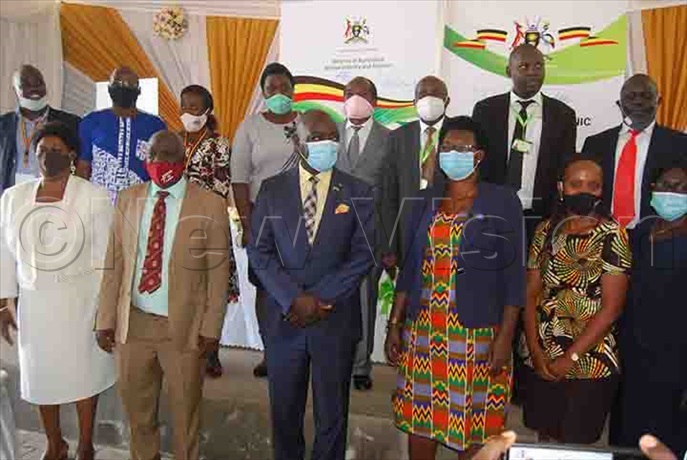How to control pests organically
Organic farmers use or can use a collection of leaves, fruits, roots to process elements to control different pests on the farm.
As the National Organic Agriculture Policy was launched on Tuesday, September 29, the potential of Uganda's organic foods sector was re-emphasized.
"We have the potential to control the international organic market," Vincent Ssempijja, Minister of Agriculture Animal Industry and Fisheries (MAAIF) said. The policy, intended to regulate organic farming in the country was launched, at MAAIF headquarters, in Entebbe.
One of the biggest challenges facing organic farmers is the control of pests in their plants. Organic farmers use or can use a collection of leaves, fruits, roots to process elements to control different pests on the farm.
Such plants include neem tree extracts, tephrosia, blackjack (sere), paw-paw leaves, etc. They also use urine, red-pepper. These can be made on the spot, or in case of urine, can be processed through 3months.
Using paw-paw
-Harvest fresh paw-paw leaves and roots about 1kg
-Ground them in a mortar properly and add 1 kg in a litre of warm water.
-Shake vigorously and then filter
-Add four litres of water
-Add a matchbox size of normal house soap, mix well and spray the plant. This concoction can fight against termites and mealy bugs. This mixture can survive for over 1month.
Using tephrosia
-Harvest five fresh leaves and crush them in a litre of water
-Soak them for 24hours
-Filter and spray after scouting for pests.
This can be used for killing mealy bugs and beetles in crops. This mixture can survive for over a month.
How to use blackjack (sere)
This can be used to control ants, mealy bugs, beetles, snails and termites
-Collect 500grams of blackjack seeds
-Boil them for 10 minutes in two litres of water
-Allow to cool, then add 3 litres of water, a teaspoon of washing soap and spray immediately
-Do not make it too concentrated. This can be stored for over 1month

How to use neem tree extracts
This can be used to control ants, snails, mealy bugs, beetles and termites
-Collect one kilogram of neem tree leaves
-Pound the leaves using a pounding mortar
-Add litres of water and then stir thoroughly every after 10minutes for one hour
-Sieve or strain out the liquid
-Add a matchbox size of normal washing soap and then spray the affected crops.
Making compost fertilizers
Various types of vegetative materials and farm waste can be used, such as maize stovers, soybean and bean stovers, finger millet, banana peelings, rice and sorghum straws, sweet potato vines, cassava or potato peelings dry and green grass, animal and poultry wastes or slurry/kitchen wastes etc.
-Dig a pit 45cm deep (square or rectangular in shape). Put the soil on one side. Put 4 poles (2m long) 1 for each corner of the pit. After setting up the pit, then chop the available materials in small pieces and put the first layer. Pile up to 45cm deep then sprinkle 10 litres of water.
Add the second layer of dry vegetation of hedge cuttings to about 20cm thick and sprinkle water then put the third layer of animal or poultry waste or slurry, this provides microorganisms that are essential for decomposition. Please sprinkle ash as it contains essential minerals.
You can then add the fourth layer (about 20cm thick), consisting of green materials from leguminous trees such as Calliandra, Leucaena, Tithonia etc. Sprinkle a little topsoil up to 5 cm thick. The soil contains bacteria, which helps in decomposition.
-Repeat the placement of layers as in the steps above starting with dry vegetation, then animal or poultry wastes/slurry, ash, green vegetation and topsoil. Remember to sprinkle water on every layer. The final pile should be 1.5-2m high at most with vertical sides and a flat top. To complete the pile, cover with a layer of 10 cm thick of topsoil. Finally, cover the whole compost pile with dry vegetation e.g. banana leaves to reduce moisture loss through evaporation.
-Monitoring decomposition: Decomposition starts 3days after pile formation. Drive a long pointed stick at an angle to check the decomposition. The stick should be left in the pile and only removed once a week. When you pull out the stick from the pile, it should be warm and moist but not wet. This confirms that decomposition is in progress, while a cold stick is an indication of no decomposition.
-Sprinkle 20 litres of water on the pile every 3 days during dry spells. After 2-3 weeks, turn the pile. Compost is ready after 6-9weeks depending on the type of material used. Ready compost should have a fresh soil smell and should not contain grass, leaves or animal or poultry waste.
-Storage: Store compost by covering with polythene or banana leaves or under a roof. Compost can be stored for 3 - 6 months.
Using urine as a fertilizer
-Collect it from the source, this may be a toilet or animal shade
-Store it in a drum or cemented pit for at least three months in order to reduce on ammonia
-Mix at the ratio of 1 litre of urine to 10litres of water and then apply on the crops.